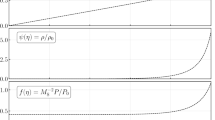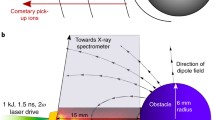Abstract
LUMINOUS phenomena accompanying shock waves have been observed under extreme conditions by Michel-Lévy, Muraour and Vassy1 through head-on collision of shocks generated by explosives, and by Perry and Kantrowitz2 at the point of convergence of a cylindrical shock wave. A related phenomenon is observed in the gas discharges of Fowler, Goldstein and Clotfelter3, although the creation of the shocks in this type of work is of an electrical nature and does not immediately allow a hydrodynamic interpretation.
Similar content being viewed by others
References
Michel-Lévy, A., Muraour, H., and Vassy, E., Rev. d'Opt., 20, 149 (1941).
Perry, R. W., and Kantrowitz, A., J. App. Phys., 22, 878 (1951).
Fowler, R. G., Goldstein, J. S., and Clotfelter, B. E., Phys. Rev., 82, 879 (1952).
Geiger, F. W., and Mautz, C. W., Engineering Research Institute, Univ. of Mich. (1949).
see, for example, Unsöld, A., “Physik der Sternatmosphären” (Berlin, 1938).
Schulz, P., Z. Naturf., 2A, 583 (1947).
Author information
Authors and Affiliations
Rights and permissions
About this article
Cite this article
HOLLYER, R., HUNTING, A., LAPORTE, O. et al. Luminosity generated by Shock Waves. Nature 171, 395–396 (1953). https://doi.org/10.1038/171395a0
Issue Date:
DOI: https://doi.org/10.1038/171395a0
- Springer Nature Limited





